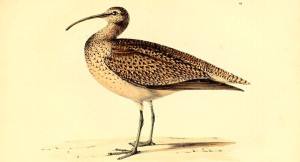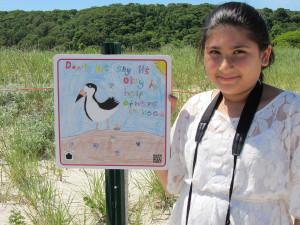The disappearance of the Eskimo Curlew exemplifies the enormous threat that humans have posed to shorebirds and their habitats over the last 150 years. Once tremendously abundant, these birds were hunted to extinction in the United States during their north- and south-bound migrations between Canadian tundra breeding sites and South American grassland wintering areas. Curlews were not alone. Almost every other shorebird species using the Atlantic Flyway was at one time hunted for their commercial value or for unregulated sport. By the 1930s, many species were in serious decline. As the Eskimo Curlew declined toward extinction, many others like the American Golden-Plover and Buff-breasted Sandpiper came perilously close to oblivion before anyone recognized the need for shorebird conservation. Along the Atlantic Flyway, it wasn’t just the migrants that were in peril. Locally-breeding species like American Oystercatcher and Willet were also hard hit. We had nearly eliminated an entire suite of species that represented the wildness of our coastlines.
Over the years the plight of these birds began to be recognized. Such recognition became poignant to many avid shorebird hunters who helped spur the birth of a new conservation ethic and inspired protective laws that allowed populations of most shorebirds to begin recovery. As a result of their call to action, we were given another chance to demonstrate our capacity as stewards for these masters of migration and ambassadors of the special places where land and water meet.
Now, shorebirds are in trouble again. Threats to shorebirds have become more diverse and widespread in recent decades and pose serious conservation challenges. The collapse of the Red Knot population; the sharp decline of Whimbrel in the mid-Atlantic; and a free-fall in numbers of Semipalmated Sandpipers wintering on the coast of South America, have all taken place during only the last twenty years. Cumulative stresses from human population expansion and commerce, particularly along coastlines, are limiting survival of shorebirds throughout the entire Atlantic Flyway.
But there is hope. Recent conservation gains, achieved for beach-nesting species show that we can reverse these downward spirals across the flyway. However, we must act fast and undertake our own collaborative, far-reaching call to action. The Atlantic Flyway Shorebird Initiative identifies major threats and detailed steps needed to reverse shorebird declines and prevent a second, potentially far more extensive wave of shorebird extinctions.
Threats
Shorebirds cross thousands of miles each year from the barren tundra of the arctic to the wind swept beaches of Tierra del Fuego in the southern hemisphere. The majority of shorebirds breeding in Alaska and Canada spend their non-breeding period in South American or Caribbean countries.
During migration, shorebirds face a multitude of challenges including:
- finding sufficient food sources to fuel their long distant migrations;
- avoiding predators;
- competing for limited habitat;
- adapting to a changing climate; and
- succumbing to sport and subsistence hunting.
The following threats are addressed in the AFSI Business Strategy. Partners are confident that alleviating many of the threats detailed in the strategy will reverse shorebird declines in the Atlantic Flyway.
Hunting

There is a pressing need to better understand the geographic scale and rates of harvest to determine how hunting affects shorebird populations.
Hunting at Caribbean and South American stopover and wintering sites is substantially contributing to shorebird population declines in the Atlantic Flyway.
There is a pressing need to better understand the geographic scale and rates of harvest to determine how hunting affects shorebird populations. With this information, projects will focus on:
- efficient and effective hunting policies;
- enforcement; and
- habitat protections
Implementing these strategies will ensure that shorebird hunting is sustainable.
Predators
Overabundant predators kill shorebird eggs, chicks, and adults in great numbers, leading to population declines. Partners are implementing coordinated predator management efforts at important nesting locations.
Links to Guidance and Best Practices and AFSI Predation Subgroup Webinars
Human Disturbance
Human disturbance of shorebirds can decrease habitat quality and rates of survival. Recreational beach use, such as off-road vehicle use, is of particular concern. Projects to reduce impacts focus on:
- standardizing shorebird protection on public lands;
- enhancing and increasing enforcement of shorebird protection laws;
- establishing broad shorebird constituencies; and
- delivering focused public outreach and education.
Links to Guidance and Best Practices and Associated Materials
Habitat Loss and Change
Many land management practices along the U.S. Atlantic coast have long-term impacts on populations of Atlantic Flyway shorebirds, eliminating beach and intertidal conditions that they require to persist. Widespread coastal engineering projects affect survival shorebirds. Other habitat management practices can also reduce critical shorebird food resources.
Partners are working with state and federal agencies to:
- develop and implement best practices for managing, restoring, enhancing, and creating shorebird habitat; and
- strengthen and enforce regulatory protection of important shorebird sites.
Information Gaps
Important information about many shorebirds in the Atlantic Flyway are unknown, including:
- the locations of critical habitats and resources they require to persist throughout the annual cycle;
- how they move across their ranges;
- major threats they face and how to mitigate them; and
- the most effective ways to measure population sizes and document demographic trends.
These knowledge gaps threaten our ability to efficiently allocate resources to shorebird conservation and impede us from evaluating conservation successes.
Climate Change
Shorebird populations are at risk of declines due to climate change. Their long migrations which require large amounts of “fuel” may be vulnerable from:
- changes in wind patterns;
- sea level rise at the coastal stopover sites; and
- the timing of food availability.


